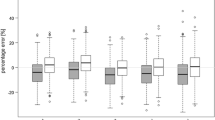Abstract
Purpose
To evaluate the influence of the time interval between examination and delivery on the accuracy of sonographic weight estimation (WE) in fetal macrosomia.
Materials and methods
896 singleton pregnancies (birth weight > 4,000 g) with a total of 1,281 sonographic weight estimations were included in this retrospective cohort study. Fetuses were divided into six groups with regard to the time interval between estimation and delivery: group 1: scan-to-delivery interval: 0 days; group 2: scan-to-delivery interval: 1–3 days; group 3: scan-to-delivery interval: 4–7 days; group 4: scan-to-delivery interval: 8–14 days; group 5: scan-to-delivery interval: 15–21 days; group 6: scan-to-delivery interval: 22–42 days. The accuracy of WE was compared between five commonly used formulas using means of percentage errors (MPE), random error, medians of absolute percentage errors (MAPE), and proportions of estimates within 10 % of actual birth weight.
Results
Significant differences were found between the time interval groups with regard to MAPE and MPE values (p < 0.001). All formulas showed a systematic underestimation of fetal weight (negative MPEs) (p < 0.05). MPE values were closest to zero in time interval group 1 and 2. From group 3 to 6, a continuous decrease was observed. The lowest MAPE was found with the Merz formula in group 1 and 2. Values increased continuously from group 3 to 6. Differences between time interval group one and three did not reach statistical significance.
Conclusions
WE in fetal macrosomia shows the best results when examinations are performed within 7 days before delivery, using the formula of Merz et al. Accuracy significantly decreases after this time period.




Similar content being viewed by others
References
Kramer MS, Morin I, Yang H et al (2002) Why are babies getting bigger? Temporal trends in fetal growth and its determinants. J Pediatr 141:538–542
Surkan PJ, Hsieh CC, Johansson AL, Dickman PW, Cnattingius S (2004) Reasons for increasing trends in large for gestational age births. Obstet Gynecol 104:720–726
Patterson RM (1985) Estimation of fetal weight during labor. Obstet Gynecol 65:330–332
Dietz HP (2010) Childbirth-related Pelvic Floor Trauma. Geburtshilfe Frauenheilkd 70:969–978
Brieger GM, Rogers MS, Rushton AW, Mongelli M (1997) Are Hong Kong babies getting bigger? Int J Gynaecol Obstet 57:267–271
Orskou J, Kesmodel U, Henriksen TB, Secher NJ (2001) An increasing proportion of infants weigh more than 4,000 grams at birth. Acta Obstet Gynecol Scand 80:931–936
Boulet SL, Alexander GR, Salihu HM, Pass M (2003) Macrosomic births in the united states: determinants, outcomes, and proposed grades of risk. Am J Obstet Gynecol 188:1372–1378
Dudley NJ (2005) A systematic review of the ultrasound estimation of fetal weight. Ultrasound Obstet Gynecol 25:80–89
Hadlock FP, Harrist RB, Sharman RS, Deter RL, Park SK (1985) Estimation of fetal weight with the use of head, body, and femur measurements–a prospective study. Am J Obstet Gynecol 151:333–337
Shepard MJ, Richards VA, Berkowitz RL, Warsof SL, Hobbins JC (1982) An evaluation of two equations for predicting fetal weight by ultrasound. Am J Obstet Gynecol 142:47–54
Hadlock FP, Harrist RB, Carpenter RJ, Deter RL, Park SK (1984) Sonographic estimation of fetal weight. The value of femur length in addition to head and abdomen measurements. Radiology 150:535–540
Merz E, Lieser H, Schicketanz KH, Harle J (1988) Intrauterine fetal weight assessment using ultrasound. A comparison of several weight assessment methods and development of a new formula for the determination of fetal weight. Ultraschall Med 9:15–24
Warsof SL, Gohari P, Berkowitz RL, Hobbins JC (1977) The estimation of fetal weight by computer-assisted analysis. Am J Obstet Gynecol 128:881–892
Melamed N, Yogev Y, Meizner I et al (2009) Sonographic fetal weight estimation: which model should be used? J Ultrasound Med 28:617–629
Siemer J, Egger N, Hart N et al (2008) Fetal weight estimation by ultrasound: comparison of 11 different formulae and examiners with differing skill levels. Ultraschall Med 29:159–164
Hoopmann M, Abele H, Wagner N, Wallwiener D, Kagan KO (2010) Performance of 36 different weight estimation formulae in fetuses with macrosomia. Fetal Diagn Ther 27:204–213
Faschingbauer F, Voigt F, Goecke TW et al (2011) Fetal weight estimation in extreme macrosomia (≥ 4,500 g): comparison of 10 formulas. Ultraschall Med
Kurmanavicius J, Burkhardt T, Wisser J, Huch R (2004) Ultrasonographic fetal weight estimation: accuracy of formulas and accuracy of examiners by birth weight from 500 to 5000 g. J Perinat Med 32:155–161
ACOG (2009) ACOG practice bulletin no. 101: ultrasonography in pregnancy. Obstet Gynecol 113:451–461
Eichhorn KH, Schramm T, Bald R, Hansmann M, Gembruch U (2006) DEGUM grade I quality standards in obstetric ultrasound diagnosis during the 19th–22nd week of pregnancy. Ultraschall Med 27:185–187
Merz E, Eichhorn KH, Hansmann M, Meinel K (2002) Quality demands on continuing differential diagnostic sonography in prenatal diagnostics (DEGUM stage II) during the 18th to 22nd weeks of gestation. Ultraschall Med 23:11–12
Heer IM, Kumper C, Vogtle N et al (2008) Analysis of factors influencing the ultrasonic fetal weight estimation. Fetal Diagn Ther 23:204–210
Basha AS, Abu-Khader IB, Qutishat RM, Amarin ZO (2012) Accuracy of sonographic fetal weight estimation within 14 days of delivery in a Jordanian population using Hadlock formula 1. Med Princ Prac Int J Kuwait Univ Health Sci Centre 21:366–369
Mongelli M, Gardosi J (1996) Gestation-adjusted projection of estimated fetal weight. Acta Obstet Gynecol Scand 75:28–31
Benacerraf BR, Gelman R, Frigoletto FD Jr (1988) Sonographically estimated fetal weights: accuracy and limitation. Am J Obstet Gynecol 159:1118–1121
Conflict of interest
None.
Author information
Authors and Affiliations
Corresponding author
Electronic supplementary material
Below is the link to the electronic supplementary material.
Rights and permissions
About this article
Cite this article
Faschingbauer, F., Dammer, U., Raabe, E. et al. Sonographic weight estimation in fetal macrosomia: influence of the time interval between estimation and delivery. Arch Gynecol Obstet 292, 59–67 (2015). https://doi.org/10.1007/s00404-014-3604-y
Received:
Accepted:
Published:
Issue Date:
DOI: https://doi.org/10.1007/s00404-014-3604-y



